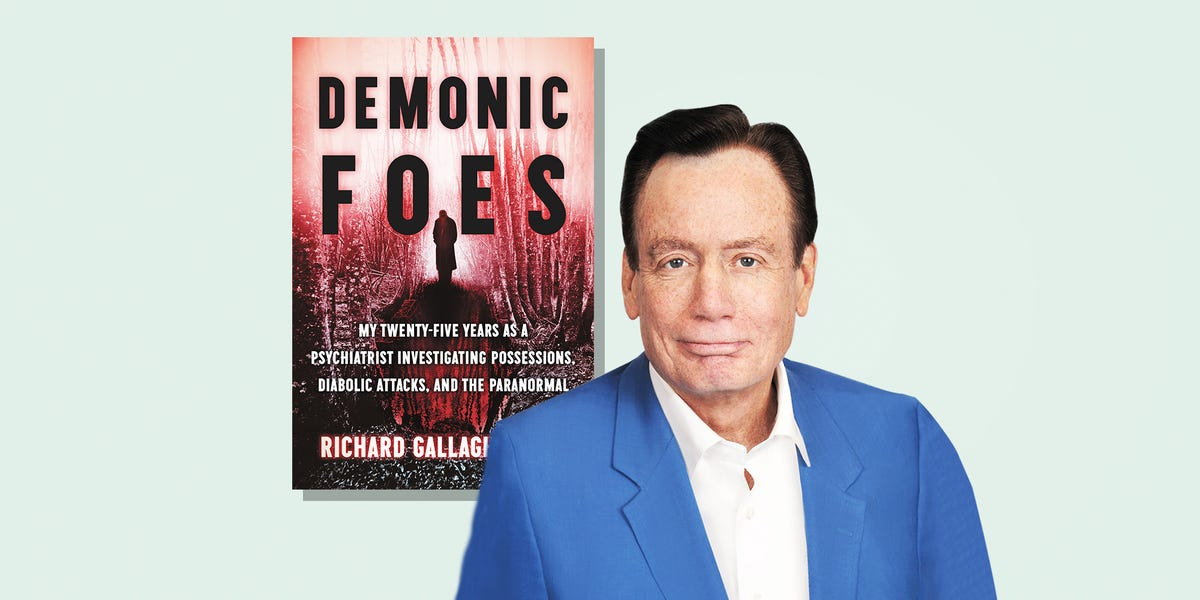🔎Paranormal Insight: Dr. Richard Gallagher
The Psychiatrist Who Believes in Demonic Possession —and helps fight it!
Editor’s Note:
This article is part of a two-part series exploring one of the most extraordinary modern cases of alleged demonic possession. In this Paranormal Insight, we examine the work of Dr. Richard Gallagher, a Yale-trained psychiatrist who has spent decades investigating spiritual phenomena. The second part — a dedicated Case File — will delve into the cases Dr. Gallagher has shared. The chilling possession case of “Julia,” the woman who convinced him that evil sometimes wears a human face.
Supporting Paranormal Casefiles by buying a coffee or a book truly means the world to me, every contribution goes straight back into the project, helping me afford research materials, archive access, and the tools I need to keep exploring and sharing these strange and unsettling stories. I'm incredibly grateful for your support.
Overview
Dr. Richard Gallagher is not your typical psychiatrist. Ivy League-educated, board-certified, and academically grounded, he also stands out as one of the few medical professionals willing to publicly affirm the reality of demonic possession. For more than two decades, Gallagher has served as a psychiatric consultant on cases of alleged spiritual oppression, possession, and exorcism, becoming a rare bridge between modern science and ancient belief systems.
This Paranormal Insight explores Gallagher's background, his methods, and the controversial role he has come to occupy in the field of spiritual investigations. Drawing on a career that blends clinical psychiatry with rare exposure to claimed preternatural phenomena, Gallagher has become one of the most well-known figures in the modern discussion of possession — both respected and reviled.
The Man Behind the Belief
Dr. Richard Gallagher’s academic pedigree is impeccable. He graduated from Princeton University with honours and went on to study medicine at Yale, eventually becoming a board-certified psychiatrist. He has held teaching positions at prestigious institutions, including New York Medical College and Columbia University. His clinical focus for most of his career has been on serious psychiatric illnesses — including schizophrenia, personality disorders, and trauma-induced conditions.
By his own account, Gallagher was once a committed sceptic. He saw religious explanations for mental illness as outdated, and possession as a superstition rooted in cultural misunderstanding. However, that changed in the early 1990s when he was approached by a Catholic priest who had encountered a case he could not explain. The priest requested Gallagher’s help to evaluate the individual in question — not to perform an exorcism, but to assess whether the person might be suffering from a diagnosable mental illness.
That case — and several others that followed — began to challenge Gallagher’s worldview. He encountered individuals who, in his professional opinion, exhibited behaviour and knowledge far outside what any psychological disorder could explain. In his words, a small percentage of cases he reviewed (fewer than 2%) appeared to involve phenomena that were “preternatural” — outside or beyond what is natural, yet distinct from miraculous.
Gallagher's Role in Possession Cases
Dr. Gallagher does not conduct exorcisms. His role is that of a consultant, a scientific assessor brought in to determine whether a person's condition might have a natural explanation. He works with clergy from various religious backgrounds — most frequently Catholic priests — to offer psychiatric insight before they proceed with spiritual rites.
His process involves rigorous interviews, psychological evaluations, collaboration with other physicians, and in many cases, long-term observation. He places great emphasis on ruling out all other explanations: psychosis, delusions, trauma, substance use, and neurological abnormalities. Only when all possible psychiatric conditions are eliminated — and when consistent, inexplicable phenomena persist — does Gallagher consider the possibility of demonic involvement.
In the rare cases he believes to be authentic, the signs he documents often include:
Accurate knowledge of hidden or distant information: Individuals describe personal details about others they have never met, including information not found in public records or known to friends or family.
Xenoglossy: Patients speak or write fluently in languages they have never studied, such as Latin, Aramaic, or Koine Greek, often in the context of curses or invocations.
Levitation and unexplained movement of objects: Witnesses, sometimes including multiple clergy and medical personnel, report seeing the individual rise off the ground or objects fly across the room without contact.
Extraordinary strength or stamina: Gallagher describes cases in which small or physically frail individuals resisted groups of adults or performed feats of strength inconsistent with their physiology.
Intense aversion to sacred symbols: In documented sessions, individuals have reacted violently to crucifixes, relics, or holy water — even when the items were hidden from view.
While Gallagher emphasises that these manifestations are rare, he insists that they are real — not metaphorically, but literally. He has repeatedly stated that denying what he has seen would be intellectually dishonest.
The Julia Case: A Turning Point
One of the most important and chilling cases of Gallagher’s career was that of “Julia,” a pseudonym given to protect the identity of a woman who came to the Church claiming to be tormented by unseen forces. Unlike many individuals seeking spiritual help, Julia did not initially claim to be religious. She identified herself as a practicing Satanist, even calling herself a high priestess in her occult circle.
Julia nevertheless sought help because she believed something had gone wrong. The rituals she had once controlled were now controlling her. She described episodes of blackout trances, violent self-harm, and terrifying outbursts she could not remember. She agreed to undergo a spiritual evaluation — but only if the Church could prove it was stronger than the forces she had aligned with.
Gallagher was called in. He observed her over several months and documented numerous incidents that, in his opinion, were beyond psychiatric explanation:
She revealed personal information about Gallagher’s own family, including the recent death of his mother and the words spoken at her funeral — information he had not disclosed to anyone.
She spoke fluent Latin and Spanish during trance states, despite having no formal education in either language.
She exhibited dissociative states with distinct vocalisations, including a deep, male-sounding voice that would insult and threaten religious figures, often mocking rituals.
Multiple observers claimed to witness her levitate, during one exorcism session, for several minutes.
Objects in the room moved or fell without physical interaction, often during moments of intense emotional or spiritual activity.
The case was never resolved. Julia eventually chose to stop the exorcism process, saying she was not ready to renounce the entity within her. Gallagher described it as the most disturbing case of possession he had ever encountered. He featured her story in his 2019 book, Demonic Foes, which documents multiple cases from his decades of work.
Controversy and Criticism
Dr. Gallagher’s work has drawn sharp criticism from many quarters of the psychiatric and scientific community. Critics argue that his conclusions are based on anecdotal reports, rely too heavily on witness testimony, and lack the controlled rigor of scientific investigation. Others point out the role of cultural expectation and group psychology in shaping supernatural claims.
Some have questioned whether Gallagher’s own religious beliefs — he is a practicing Catholic — have biased his interpretations. They argue that even strange and vivid experiences can emerge from dissociation, trauma, and psychosomatic expression, particularly in highly suggestible environments.
However, Gallagher has addressed these critiques directly. He asserts that belief alone does not account for the consistency, duration, and corroboration involved in the cases he has worked on. He is careful to say that he does not label all unusual behaviour as possession. In fact, the vast majority of his consults, he says, are resolved with a medical or psychological explanation.
He insists that he is not trying to proselytise, nor does he offer his services to the public. He is called only by clergy, and only when other avenues have failed.
Bridging Worlds
Dr. Richard Gallagher occupies a rare and uncomfortable space: a credentialed man of science who has come to believe in something the modern world considers unprovable. He is often described as either a maverick or a heretic, depending on which side of the debate one falls on.
For paranormal researchers, Gallagher is a figure of rare credibility — a psychiatrist who brings academic weight to claims often dismissed outright. For sceptics, he remains a troubling reminder that even trained scientists are not immune to the power of belief.
But perhaps Gallagher’s true legacy is not in the conclusions he draws, but in the questions he forces us to ask: What if the line between psychology and spirituality is thinner than we think? What happens when medicine fails — and something else takes its place? And most of all: What if some horrors truly do exist beyond science?
👻 Psst… You made it to the end!
Hey reader,
I’m Ghosty — and if you’ve stuck around this long, chances are you’ve got thoughts.
We’d love to hear what you think — about this case file, the overall vibe, or anything in between.
Your feedback helps keep _Paranormal Case Files_ strange in all the right ways.
Thanks for lurking with us.
— Ghosty





